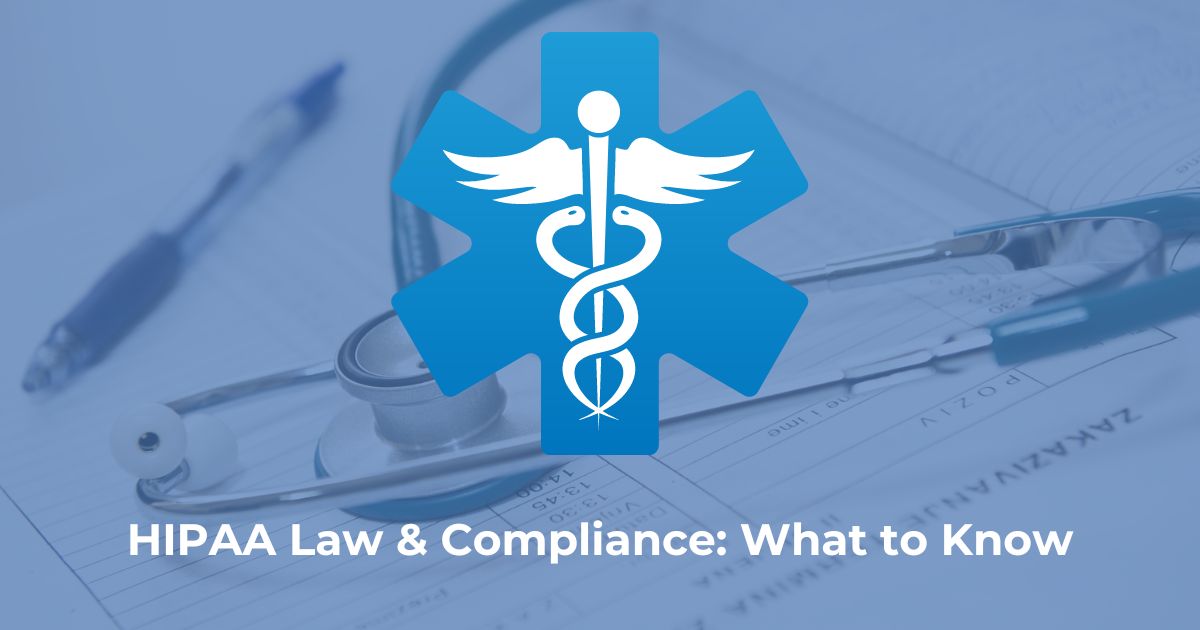HIPAA compliance represents a transformative milestone in U.S. healthcare history, dividing it into distinct eras: pre-HIPAA and post-HIPAA. This legislation revolutionized patient data management by setting stringent standards for the collection, storage, access, and sharing of data. Over 25 years later, HIPAA’s influence remains profound, shaping how organizations handle protected health information (PHI).
This blog will discuss HIPAA’s significance, outlining its key provisions and emphasizing its enduring relevance. Understanding HIPAA is crucial for healthcare providers to navigate regulatory compliance and safeguard patient privacy and security effectively.
What is HIPAA?
The Health Insurance Portability and Accountability Act (HIPAA), enacted in 1996, is U.S. legislation that works to protect patient health information. It aimd to improve the efficiency and effectiveness of the healthcare system by mandating stringent guidelines for safeguarding sensitive patient data.
HIPAA’s scope is broad, encompassing various rules that healthcare providers, insurers, and associated entities must follow. One of the core components is the HIPAA Privacy Rule, which sets national standards for protecting medical records and other personal health information. This rule gives patients rights over their health information, including the right to examine and obtain a copy of their health records and request corrections.
The HIPAA Security Rule complements the Privacy Rule by specifying safeguards covered entities must implement to protect electronic protected health information (ePHI). These include administrative, physical, and technical measures designed to ensure the confidentiality, integrity, and security of ePHI.
Additionally, HIPAA includes the Breach Notification Rule, which requires covered entities to notify affected individuals, the Secretary of Health and Human Services, and, in some cases, the media- if a breach of unsecured PHI occurs.
HIPAA compliance is crucial for maintaining patient trust and avoiding substantial penalties. By understanding and adhering to HIPAA regulations, healthcare organizations can ensure they handle patient information responsibly and securely in an increasingly digital healthcare environment.
The History and Evolution of HIPAA
The Health Insurance Portability and Accountability Act (HIPAA) was signed into law by President Bill Clinton on August 21, 1996. Initially, HIPAA aimed to improve the portability and continuity of health insurance coverage for American workers and their families during job changes or losses. However, its scope soon expanded to address the growing need for healthcare information privacy and security standards.
In its early years, HIPAA focused on administrative simplification, promoting electronic transactions to improve efficiency in the healthcare system. This transition led to the establishment of specific standards for electronic health transactions, such as claims and remittance advice, which helped streamline healthcare operations and reduce costs.
The Privacy Rule, enacted in 2003, marked a significant milestone by setting national standards for protecting individuals’ medical records and other personal health information. This rule granted patients greater control over their health information, ensuring that consent would be a requirement before disclosing any information.
The Security Rule, implemented in 2005, further strengthened HIPAA by requiring covered entities to implement administrative, physical, and technical safeguards to protect electronic protected health information (ePHI). This rule was crucial as the healthcare industry increasingly transitioned to digital records.
In response to growing threats and breaches, the Health Information Technology for Economic and Clinical Health (HITECH) Act of 2009 expanded HIPAA’s reach, increasing penalties for non-compliance and mandating breach notifications.
Today, HIPAA remains a cornerstone of healthcare regulation, continuously adapting to new technological advancements and challenges to protect protected health information.
Components of HIPAA Regulations
The Health Insurance Portability and Accountability Act (HIPAA) design comprises several fundamental components that protect patient information and ensure healthcare data integrity. The main elements of HIPAA regulations are the Privacy Rule, the Security Rule, and the Breach Notification Rule.
The Privacy Rule was established in 2003 and sets national standards for protecting medical records and other personal health information (PHI). It gives patients significant rights over their health information, including rights to access and request corrections to their health records. The Privacy Rule dictates how healthcare providers, insurers, and their business associates can use and disclose PHI data, ensuring that patient information remains confidential and requires specific, legally permissible circumstances to share it.
The Security Rule, implemented in 2005, complements the Privacy Rule by setting standards for protecting electronic protected health information (ePHI). It requires covered entities to implement comprehensive administrative, physical, and technical safeguards. These include encryption, access, and audit controls- designed to protect ePHI from unauthorized access, alteration, and breaches.
The Breach Notification Rule, part of the HITECH Act amendments of 2009, mandates that covered entities and their business associates notify affected individuals, the Secretary of Health and Human Services, and sometimes the media, of any breaches of unsecured PHI. This rule ensures transparency and accountability that helps mitigate the impact of data breaches on patients.
Together, these components form the backbone of HIPAA, ensuring that patient information adheres to the highest privacy and security standards.
HIPAA Privacy Rule: Protecting Patient Information

The HIPAA Privacy Rule, enacted in 2003, establishes critical national standards for protecting medical records and other personal health information (PHI). Its primary goal is to ensure that individuals’ health information remains confidential and secure while allowing the necessary flow of information to provide high-quality healthcare and protect public health.
Under the Privacy Rule, covered entities—including healthcare providers, health plans, and healthcare clearinghouses—are required to implement safeguards to protect PHI and ensure that it is not disclosed without patient consent, except under specific circumstances such as treatment, payment, and healthcare operations.
One of the Privacy Rule’s core provisions is granting patients significant rights over their health information. Patients can access their medical records, request corrections, and obtain an accounting of disclosures of their medical data. They can also request additional privacy protections, such as restricting information sharing with certain parties.
The Privacy Rule also mandates that covered entities notify patients of their privacy practices, detailing how their information will be used and shared. This transparency helps patients understand their rights and the measures to protect their information.
HIPAA Security Rule: Safeguarding Electronic Health Data
The HIPAA Security Rule, implemented in 2005, establishes a comprehensive framework for protecting electronic protected health information (ePHI). Its primary objective is to ensure the confidentiality, integrity, and availability of ePHI, thereby safeguarding sensitive patient data from unauthorized access and breaches in an increasingly digital healthcare environment.
The Security Rule applies to covered entities such as healthcare providers, health plans, and healthcare clearinghouses, and their business associates. It mandates administrative, physical, and technical safeguards designed to protect ePHI.
Administrative safeguards involve policies and procedures for managing the selection, development, and implementation of security measures. These safeguards include conducting risk assessments, training employees, and establishing contingency plans.
Physical safeguards focus on protecting the actual hardware and facilities where ePHI is stored. This process includes controlling physical access to systems, using secure workstations, and implementing device and media controls to prevent unauthorized access or theft.
Technical safeguards involve technology and the policies that protect ePHI and control access to it. These include access controls like unique user IDs and encryption, audit controls to monitor system activity, and transmission security to protect data transmitted over networks.
Together, these safeguards form a vital defense against data breaches and unauthorized access, ensuring that patient information remains protected in the digital age. Healthcare organizations can build patient trust and maintain compliance with federal regulations by sticking to the HIPAA Security Rule.
The Importance of HIPAA Compliance for Healthcare Providers
HIPAA compliance is crucial for healthcare providers as it protects patient information, upholds patient trust, and avoids substantial legal and financial penalties. Adherence to HIPAA regulations is not just a legal obligation but a fundamental component of providing quality healthcare in a digital age where data breaches and cyber threats are increasingly common.
First and foremost, HIPAA compliance safeguards patient privacy. Healthcare providers can protect sensitive health information from unauthorized access and breaches by implementing administrative, physical, and technical safeguards. This protection is essential for maintaining patient trust, as individuals are more likely to share accurate and complete health information if they believe their data is secure.
Moreover, compliance with HIPAA helps healthcare providers avoid hefty fines and legal consequences. Depending on the severity of the violation, non-compliance can result in penalties ranging from thousands to millions of dollars. These penalties can severely impact the financial stability of healthcare organizations, making compliance a sound financial practice.
Additionally, HIPAA compliance fosters a culture of accountability and continuous improvement within healthcare organizations. It encourages the best data management and security practices, leading to more efficient and effective healthcare delivery.
Understanding HIPAA Violations and Penalties
Understanding HIPAA violations and their associated penalties is crucial for healthcare organizations to ensure compliance and protect patient information. HIPAA violations occur when covered entities or business associates fail to adhere to the standards and regulations outlined in the HIPAA.
There are several types of HIPAA violations, each with its own implications. These violations range from unintentional breaches, which can occur due to a lack of awareness or training, to deliberate disregard for patient privacy and security. Common violations include unauthorized disclosure of protected health information (PHI), failure to implement required safeguards to protect PHI, and failure to notify affected individuals and regulatory authorities, in the event of a data breach.
The penalties for HIPAA violations are not to be taken lightly. HIPAA violation fines can vary depending on the severity of the offense. Civil penalties can range from $100 to $50,000 per violation, with an annual maximum penalty of $1.5 million for each violation category. The penalties can be much higher in cases of willful neglect that did not receive rectification within the allotted timeframe.
HIPAA violations can result in civil penalties and criminal charges, particularly in cases with deliberate or malicious misconduct. Criminal penalties can include fines of up to $250,000 and imprisonment for up to 10 years for individuals guilty of HIPAA violations.
How to Implement HIPAA Policies in Your Practice

Implementing HIPAA policies in your practice is essential to protect patient information and maintain compliance with federal regulations. Here are steps to effectively implement HIPAA policies:
- Conduct a comprehensive risk assessment: Assess potential risks and vulnerabilities to patient information within your practice. Identify areas where PHI is stored, accessed, or transmitted and evaluate existing security measures.
- Develop HIPAA policies and procedures: Create clear and comprehensive policies and procedures that address HIPAA requirements. These include policies for data access, security, breach response, and employee training.
- Train staff: Provide HIPAA training to all staff members who handle PHI. Ensure they understand their roles and responsibilities in protecting patient information and complying with HIPAA regulations.
- Implementing security measures: Implement administrative, physical, and technical safeguards to protect PHI. These may include access controls, encryption, secure storage, and regular security audits.
- Monitor compliance: Regularly monitor and audit compliance with HIPAA policies and procedures. Conduct internal audits, review access logs, and address any identified issues promptly.
- Respond to breaches: Establish procedures for responding to and reporting data breaches. Develop a breach response plan outlining steps to contain the breach, notify affected individuals, and report the incident to regulatory authorities.
- Stay updated: Stay informed about changes to HIPAA regulations and update policies and procedures accordingly. Regularly review and revise HIPAA policies to ensure they remain effective and compliant.
Common HIPAA Myths and Misconceptions
Despite its significance for the healthcare industry, HIPAA is frequently misinterpreted, giving rise to several false beliefs. Here are some common HIPAA myths debunked:
- HIPAA applies only to electronic records: While HIPAA’s Security Rule primarily addresses electronic protected health information (ePHI), it also covers paper records and oral communications. All forms of PHI are subject to HIPAA regulations.
- HIPAA prohibits sharing any patient information. However, it allows for the sharing of patient information for treatment, payment, and healthcare operations without patient authorization. Sharing PHI for other purposes requires patient consent or must fall under specific exceptions outlined in the Privacy Rule.
- HIPAA compliance is optional for small healthcare providers. However, regardless of size, all healthcare providers that transmit health information electronically must comply with HIPAA regulations. Non-compliance can result in significant penalties.
- HIPAA prevents family members from accessing patient information. However, it permits healthcare providers to share patient information with family members involved in a patient’s care unless the patient has explicitly objected.
- HIPAA compliance guarantees complete data security: While HIPAA sets standards for protecting patient information, it cannot guarantee absolute security. Compliance requires ongoing risk assessments and appropriate safeguards to mitigate security risks.
HIPAA and Telehealth: Ensuring Secure Virtual Care
HIPAA and telehealth intersect at a critical juncture in modern healthcare, especially with the increasing adoption of virtual care technologies. Telehealth offers unprecedented convenience and accessibility, allowing patients to receive medical services remotely. However, it also introduces unique challenges regarding patient privacy and security.
HIPAA laws and regulations apply to telehealth services, requiring healthcare providers to ensure patient information’s confidentiality, integrity, and availability during virtual consultations. This regulation means implementing appropriate safeguards to protect electronic protected health information (ePHI) transmitted over telehealth platforms.
Healthcare providers offering telehealth services must use HIPAA-compliant communication platforms and secure, encrypted connections to protect patient data from unauthorized access or interception. Additionally, they must adhere to HIPAA’s Privacy Rule and Security Rule requirements, including obtaining patient consent for telehealth services, conducting risk assessments, and implementing appropriate administrative, physical, and technical safeguards.
Ensuring HIPAA compliance in telehealth is essential for maintaining patient trust and confidentiality while leveraging the benefits of virtual care. By prioritizing patient privacy and security in telehealth practices, healthcare providers can deliver high-quality care remotely while mitigating the risks of handling sensitive patient information in a digital environment.
The Role of Business Associates in HIPAA Compliance
Business associates are vital to HIPAA compliance, often handling protected health information (PHI) for covered entities like providers and insurers. They must follow strict privacy and security guidelines to ensure PHI is protected. A business associate is any entity that performs functions or services for a covered entity that involves the use or disclosure of PHI. Business associates can range from many entities, such as billing companies, IT service providers, and third-party administrators.
Under HIPAA regulations, business associates are required to comply with the same privacy and security standards as covered entities. This regulation means they must implement appropriate safeguards to protect PHI, including administrative, physical, and technical measures. Business associates are also subject to HIPAA’s breach notification requirements and must report any breaches of unsecured PHI to the covered entity.
Additionally, business associates must enter into a written agreement, known as a business associate agreement (BAA), with covered entities outlining their responsibilities for protecting PHI. This agreement specifies the terms and conditions of the business associate’s use and disclosure of PHI and establishes liability for compliance with HIPAA regulations.
Business associates’ role in HIPAA compliance is essential for protecting patient information and maintaining the integrity of the healthcare ecosystem. Collaboration between covered entities and business associates is crucial to safeguarding PHI and upholding the principles of patient privacy and security.
Recent Updates and Changes in HIPAA Regulations
In the past, updates to HIPAA have often been driven by advancements in technology, changes in healthcare practices, and evolving threats to patient privacy and data security. For example, the Health Information Technology for Economic and Clinical Health (HITECH) Act of 2009 introduced significant amendments to HIPAA, including enhanced enforcement mechanisms and breach notification requirements.
Additionally, regulatory agencies such as the Department of Health and Human Services’ Office for Civil Rights (OCR) periodically issue guidance and clarifications on HIPAA requirements to help covered entities and business associates understand and comply with the law.
In the fast-evolving healthcare and tech landscape, organizations must stay informed about updates to HIPAA regulations. Staying current requires monitoring official channels like the OCR website and consulting legal experts to ensure ongoing compliance.
Future Trends in HIPAA-Compliance and Healthcare Privacy
When looking ahead, several key trends are likely to shape the future of HIPAA and healthcare privacy. One major trend is the increasing use of digital health technologies, such as wearable devices, remote monitoring systems, and telehealth platforms. While these technologies offer new opportunities for improving patient care and outcomes, they also raise significant privacy and security concerns. Future HIPAA regulations may evolve to address challenges like securing telehealth data and protecting health information from wearable devices.
Another trend is the growing importance of data interoperability and information exchange in healthcare. As healthcare organizations seek to share patient information more smoothly across disparate systems and platforms, there will be a need for stricter guidelines and standards for protecting the privacy and security of this information. Future HIPAA regulations may promote interoperability while ensuring that patient data is adequately protected from unauthorized access or disclosure.
The rise of cybersecurity threats in healthcare highlights the need for strong security measures and incident response protocols. Future HIPAA regulations may focus on cybersecurity readiness, urging organizations to adopt advanced technologies to protect patient data. Strengthening these defenses is essential to safeguarding sensitive information and maintaining compliance in an evolving digital landscape.
Technological advancements, evolving practices, and emerging threats will shape the future of HIPAA and healthcare privacy. By adapting to trends and challenges, healthcare organizations can protect patient privacy and maintain HIPAA compliance in the future.
Trust HIPAA Website Hosting for HIPAA-Compliant Hosting Solutions
Ensuring HIPAA compliance is vital for healthcare organizations to protect patient privacy and security in an increasingly digital healthcare industry. With the growing reliance on technology, healthcare providers must prioritize HIPAA compliance to safeguard patient information effectively.
At HIPAA Website Hosting HWH, we understand the critical importance of HIPAA compliance in healthcare operations. Our managed hosting solutions are designed to meet the stringent requirements of HIPAA regulations, providing a secure and reliable platform for hosting electronically protected health information (ePHI).
Partner with HWH to leverage HIPAA compliance expertise and managed hosting, ensuring secure data and focused patient care. Contact us today to learn more about our HIPAA-compliant hosting solutions and take the first step toward safeguarding your organization’s sensitive patient information.
